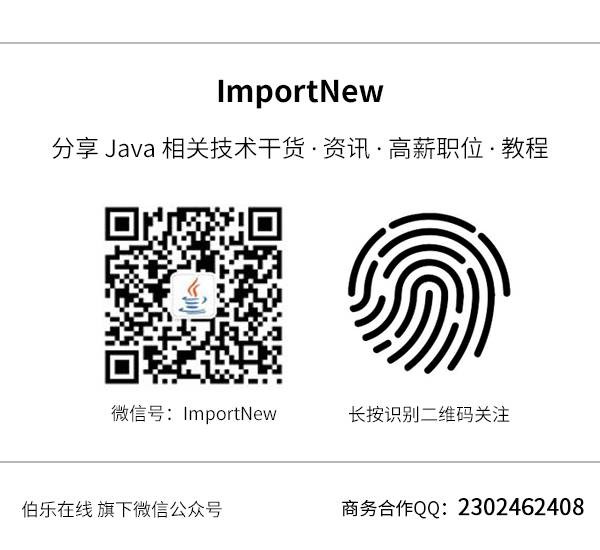(點選上方公眾號,可快速關註)
來源:ImportNew – 劉志軍
生產者消費者樣式是併發、多執行緒程式設計中經典的設計樣式,生產者和消費者透過分離的執行工作解耦,簡化了開發樣式,生產者和消費者可以以不同的速度生產和消費資料。這篇文章我們來看看什麼是生產者消費者樣式,這個問題也是多執行緒面試題中經常被提及的。如何使用阻塞佇列(Blocking Queue)解決生產者消費者樣式,以及使用生產者消費者樣式的好處。
真實世界中的生產者消費者樣式
生產者和消費者樣式在生活當中隨處可見,它描述的是協調與協作的關係。比如一個人正在準備食物(生產者),而另一個人正在吃(消費者),他們使用一個共用的桌子用於放置盤子和取走盤子,生產者準備食物,如果桌子上已經滿了就等待,消費者(那個吃的)等待如果桌子空了的話。這裡桌子就是一個共享的物件。在Java Executor框架自身實現了生產者消費者樣式它們分別負責新增和執行任務。
生產者消費者樣式的好處
它的確是一種實用的設計樣式,常用於編寫多執行緒或併發程式碼。下麵是它的一些優點:
-
它簡化的開發,你可以獨立地或併發的編寫消費者和生產者,它僅僅只需知道共享物件是誰
-
生產者不需要知道誰是消費者或者有多少消費者,對消費者來說也是一樣
-
生產者和消費者可以以不同的速度執行
-
分離的消費者和生產者在功能上能寫出更簡潔、可讀、易維護的程式碼
多執行緒中的生產者消費者問題
生產者消費者問題是一個流行的面試題,面試官會要求你實現生產者消費者設計樣式,以至於能讓生產者應等待如果佇列或籃子滿了的話,消費者等待如果佇列或者籃子是空的。這個問題可以用不同的方式來現實,經典的方法是使用wait和notify方法在生產者和消費者執行緒中合作,在佇列滿了或者佇列是空的條件下阻塞,Java5的阻塞佇列(BlockingQueue)資料結構更簡單,因為它隱含的提供了這些控制,現在你不需要使用wait和nofity在生產者和消費者之間通訊了,阻塞佇列的put()方法將阻塞如果佇列滿了,佇列take()方法將阻塞如果佇列是空的。在下部分我們可以看到程式碼例子。
使用阻塞佇列實現生產者消費者樣式
阻塞佇列實現生產者消費者樣式超級簡單,它提供開箱即用支援阻塞的方法put()和take(),開發者不需要寫困惑的wait-nofity程式碼去實現通訊。BlockingQueue 一個介面,Java5提供了不同的現實,如ArrayBlockingQueue和LinkedBlockingQueue,兩者都是先進先出(FIFO)順序。而ArrayLinkedQueue是自然有界的,LinkedBlockingQueue可選的邊界。下麵這是一個完整的生產者消費者程式碼例子,對比傳統的wait、nofity程式碼,它更易於理解。
import java.util.concurrent.BlockingQueue;
import java.util.concurrent.LinkedBlockingQueue;
import java.util.logging.Level;
import java.util.logging.Logger;
public class ProducerConsumerPattern {
public static void main(String args[]){
//Creating shared object
BlockingQueue sharedQueue = new LinkedBlockingQueue();
//Creating Producer and Consumer Thread
Thread prodThread = new Thread(new Producer(sharedQueue));
Thread consThread = new Thread(new Consumer(sharedQueue));
//Starting producer and Consumer thread
prodThread.start();
consThread.start();
}
}
//Producer Class in java
class Producer implements Runnable {
private final BlockingQueue sharedQueue;
public Producer(BlockingQueue sharedQueue) {
this.sharedQueue = sharedQueue;
}
@Override
public void run() {
for(int i=0; i<10; i++){
try {
System.out.println(“Produced: ” + i);
sharedQueue.put(i);
} catch (InterruptedException ex) {
Logger.getLogger(Producer.class.getName()).log(Level.SEVERE, null, ex);
}
}
}
}
//Consumer Class in Java
class Consumer implements Runnable{
private final BlockingQueue sharedQueue;
public Consumer (BlockingQueue sharedQueue) {
this.sharedQueue = sharedQueue;
}
@Override
public void run() {
while(true){
try {
System.out.println(“Consumed: “+ sharedQueue.take());
} catch (InterruptedException ex) {
Logger.getLogger(Consumer.class.getName()).log(Level.SEVERE, null, ex);
}
}
}
}
Output:
Produced: 0
Produced: 1
Consumed: 0
Produced: 2
Consumed: 1
Produced: 3
Consumed: 2
Produced: 4
Consumed: 3
Produced: 5
Consumed: 4
Produced: 6
Consumed: 5
Produced: 7
Consumed: 6
Produced: 8
Consumed: 7
Produced: 9
Consumed: 8
Consumed: 9
你可以看到生產者執行緒生產數和消費者執行緒消費它以FIFO的順序,因為阻塞佇列只允許元素以FIFO的方式來訪問。以上就是使用阻塞佇列解決生產者消費者問題的全部,我確信它比wait/notify更簡單,但你要兩者都準備如果你是去面試話。
看完本文有收穫?請轉發分享給更多人
關註「ImportNew」,提升Java技能

 知識星球
知識星球